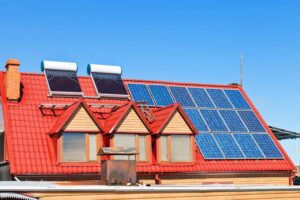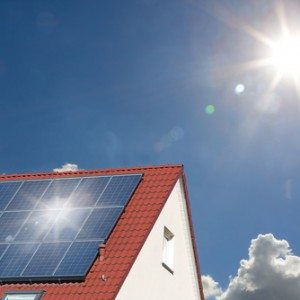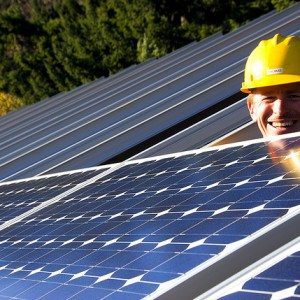One of the beauties of solar power is that, once installed, solar panels require little maintenance throughout their rated lifetime. The initial startup cost of installation can be a deterrent for many homeowners, but in reality, the monthly energy savings pay back the installation costs relatively quickly. With limited maintenance costs, solar panels really are strong long-term investments.
- Home
- Residential
- Commercial
- Tesla
- Customer Reviews
- About Us
- Contact Us
Category: Solar Maintenance
Solar panel long-term reliability
Written by goldensolar on . Posted in Solar Maintenance, Solar Panels, Solar Power.
A recent study shows that photovoltaic systems are reliable and operating as expected, with 80% to 90% of all systems performing within 10% of the predicted production or better. This peer-reviewed study was based on the largest to date assessment of 100,000 solar systems. Newer solar panels have even lower rates of degradation, so are likely to produce 85-90% as much electricity after 25 years as they did when new.
The lifespan of a solar panel is much longer than its “energy payback time,” or the time it takes for a solar panel to produce enough clean energy to “pay back” the energy that was used in its manufacturing processes.

Sources:
https://onlinelibrary.wiley.com/doi/abs/10.1002/pip.3262
https://www.nrel.gov/docs/fy12osti/51664.pdf
https://news.energysage.com/how-long-do-solar-panels-last/

Sources:
https://onlinelibrary.wiley.com/doi/abs/10.1002/pip.3262
https://www.nrel.gov/docs/fy12osti/51664.pdf
https://news.energysage.com/how-long-do-solar-panels-last/
What does diminished sunlight mean for solar panels
Written by goldensolar on . Posted in Solar Maintenance, Solar Panels, Solar Power. Leave a Comment
 Whether you’re considering a solar panel system for your home or you already have one installed, you may have wondered how well it will work on days when there isn’t bright sun or there’s particularly inclement weather. It’s actually a very reasonable inquiry, as most people think of solar panels as functioning ideally in bright sunlight, which is not necessarily available continuously or even for a majority of the day in all geographic areas. In certain regions, at certain times of the year, such as the far north in winter, the sun may set in the late afternoon and not rise again until well into the next morning.
Whether you’re considering a solar panel system for your home or you already have one installed, you may have wondered how well it will work on days when there isn’t bright sun or there’s particularly inclement weather. It’s actually a very reasonable inquiry, as most people think of solar panels as functioning ideally in bright sunlight, which is not necessarily available continuously or even for a majority of the day in all geographic areas. In certain regions, at certain times of the year, such as the far north in winter, the sun may set in the late afternoon and not rise again until well into the next morning.
Efficiency vs. Sunlight Availability
However, according to researchers at Northern Illinois University, a solar power system can function at 70 percent of its capacity even when direct sunlight isn’t at hand, ie, when skies are overcast or there’s shade. Ambient light from the day is still enough to provide power. Precipitation can provide challenges for solar panels, but when it comes to hail, for instance, as long as the speed of the hailstones is less than 50 miles per hour and their diameter doesn’t exceed one inch, normal solar panels can withstand the stones’ impact and are tested for such conditions when they’re manufactured, as reported in Mother Earth News. A typical solar panel installation is made to withstand high winds at the extremes of those of the local areas in which it’s installed. For instance, on the East Coast of the U.S., solar panels are designed to hold up under intense hurricane and tropical storm conditions that are sometimes seen in those states. Especially in the North, homeowners want to know what impact snow will have. The answer is that snow typically melts off the surface of the panels because they’re designed to face the direction the sun will most often be in. The sun’s rays will thus shine directly onto the snow, causing it to melt. In fact, in an article on accuweather.com, Associate Professor Joshua Pearce of Michigan Tech University writes that surrounding snow can actually boost the output of the panels because the white surface of the snow reflects the light. Large accumulations of snow can be removed with a roof rake without fear of damaging most panels. Rain also can be a benefit for solar panels because it can wash away dirt and dust that can lower energy output due to clouding or spotting. Even on a cloudy day with significant rain, the amount of light visible in the sky will still produce power from the panels. And despite the decreased output in energy due to these conditions, expected advances in solar panel technology will increase efficiency and compensate for the diminished extent of direct sun in certain regions or on particular days. Indeed, for homeowners, the future is bright for solar power.The Importance of Solar Panel Maintenance
Written by goldensolar on . Posted in Solar Maintenance, Solar Power. 1 Comment
 One of the beauties of solar power is that, once installed, solar panels require little maintenance throughout their rated lifetime. The initial startup cost of installation can be a deterrent for many homeowners, but in reality, the monthly energy savings pay back the installation costs relatively quickly. With limited maintenance costs, solar panels really are strong long-term investments.
In general, photovoltaic (PV) systems come with a 20-year warranty and a guarantee that the solar panels will continue to produce at least 80% of their rated power after the initial 20-year period. Solar panel durability has improved in lockstep with improvements in PV technology and manufacturing, however, so a solar panel produced after the year 2000 will only degrade by 0.4% a year. At this rate, it will retain 92% of its original efficiency after 20 years. Yet, even with this minimal degradation, there are some basic maintenance tasks that can be done to reduce the wear and tear on the panels and maintain high efficiency throughout the lifetime of the system.
Homeowners with solar panel installations should be primarily concerned with keeping the panels free of dirt and debris. This will be a bigger problem in systems with flat-lying panels, as opposed to those oriented at an angle. Anything that covers the panels will reduce the electrical output of the system, so it is important to not let some dust reduce the efficiency of the system. In most cases, simply spraying the solar panels with a hose will suffice, but you could also use a sponge on a pole to squeegee the panels and remove any stickier items, like bird droppings. Many solar companies also offer cleaning services and there are cleaning supplies available for purchase on the internet.
Similar to keeping the panels clear, it is important to ensure clear access to sunlight. Solar access could be impeded by overgrown vegetation or new structures, so always keep an eye on what’s happening south of the installation. It may be necessary to trim back some trees or talk to your neighbor so they don’t block your sunlight.
Solar panels are more susceptible in harsh climates, particularly those that experience heavy snowfall, strong winds, or frequent hail. If space and the angle of the panels permit, homeowners may consider erecting a buffer to protect the panels from the worst of the climate. Reducing the direct impact to the solar panels will extend their lifetime and improve efficiency.
There are other, rarer, things to look out for as well. Ideally, your solar panels will not much that can fall on them, but there could be instances when they are damaged by hail, or falling sticks, or a rogue cat. Keep an eye out for broken glass on the top of the panels; if there is broken glass the solar panel could be compromised and will need to be replaced.
One of the beauties of solar power is that, once installed, solar panels require little maintenance throughout their rated lifetime. The initial startup cost of installation can be a deterrent for many homeowners, but in reality, the monthly energy savings pay back the installation costs relatively quickly. With limited maintenance costs, solar panels really are strong long-term investments.
In general, photovoltaic (PV) systems come with a 20-year warranty and a guarantee that the solar panels will continue to produce at least 80% of their rated power after the initial 20-year period. Solar panel durability has improved in lockstep with improvements in PV technology and manufacturing, however, so a solar panel produced after the year 2000 will only degrade by 0.4% a year. At this rate, it will retain 92% of its original efficiency after 20 years. Yet, even with this minimal degradation, there are some basic maintenance tasks that can be done to reduce the wear and tear on the panels and maintain high efficiency throughout the lifetime of the system.
Homeowners with solar panel installations should be primarily concerned with keeping the panels free of dirt and debris. This will be a bigger problem in systems with flat-lying panels, as opposed to those oriented at an angle. Anything that covers the panels will reduce the electrical output of the system, so it is important to not let some dust reduce the efficiency of the system. In most cases, simply spraying the solar panels with a hose will suffice, but you could also use a sponge on a pole to squeegee the panels and remove any stickier items, like bird droppings. Many solar companies also offer cleaning services and there are cleaning supplies available for purchase on the internet.
Similar to keeping the panels clear, it is important to ensure clear access to sunlight. Solar access could be impeded by overgrown vegetation or new structures, so always keep an eye on what’s happening south of the installation. It may be necessary to trim back some trees or talk to your neighbor so they don’t block your sunlight.
Solar panels are more susceptible in harsh climates, particularly those that experience heavy snowfall, strong winds, or frequent hail. If space and the angle of the panels permit, homeowners may consider erecting a buffer to protect the panels from the worst of the climate. Reducing the direct impact to the solar panels will extend their lifetime and improve efficiency.
There are other, rarer, things to look out for as well. Ideally, your solar panels will not much that can fall on them, but there could be instances when they are damaged by hail, or falling sticks, or a rogue cat. Keep an eye out for broken glass on the top of the panels; if there is broken glass the solar panel could be compromised and will need to be replaced.How to Maintain Solar Panels
Written by goldensolar on . Posted in Solar Maintenance, Solar Power. Leave a Comment
 The average homeowner, after paying a small fortune for solar panels, definitely wants to keep them in good working order for many years to come. One way this can be accomplished is by maintaining the solar panels on a regular basis to ensure they remain efficient and effective.
While maintaining solar panels may sound like a difficult task, solar panels actually require little maintenance, unlike the average generator. Solar panels don’t have moving components, so homeowners don’t have to worry about moving parts rusting or breaking down.
The average homeowner, after paying a small fortune for solar panels, definitely wants to keep them in good working order for many years to come. One way this can be accomplished is by maintaining the solar panels on a regular basis to ensure they remain efficient and effective.
While maintaining solar panels may sound like a difficult task, solar panels actually require little maintenance, unlike the average generator. Solar panels don’t have moving components, so homeowners don’t have to worry about moving parts rusting or breaking down.
Cleaning the Solar Panels
One way a homeowner can maintain solar panels is by cleaning them on a regular basis. If one lives in an especially dusty area, it is recommended that the homeowner inspects and cleans the solar panels on a regular basis. Things like dirt, debris, bird droppings, and grime will reduce the efficiency of the solar panels. Therefore, homeowners should clean the solar panels on a regular basis to ensure accumulations don’t occur. If there are coats of dust on the solar panels, homeowners can clean it off easily by using a garden hose. In some cases, a garden hose may not do a proper job of cleaning your solar panels. For a more thorough cleaning use a long pole with a sponge of soapy water and rinse. Unfortunately, the solar panels may either be too high to reach or in an area that is dangerous to access yourself. In these cases, hire a professional to help maintain your solar panels.Install a Monitoring System
Another way in which one can maintain solar panels is by installing a monitoring system. Usually, one will have to pay a monthly fee for the monitoring system, but the money one pays for the monitoring system will be well-spent because they won’t have to worry about the solar panels becoming unusable due to lack of maintenance. A monitoring system will track the performance of the solar panels. If one notices the performance of the solar panel system going down, this will be an indicator that the system needs some maintenance of some sort. The monitoring system will indicate which parts of the solar panels need maintenance or repair. The monitoring system will keep track of how much energy is produced by the solar panels. It will also show how a homeowner is benefiting the environment by using solar panels. For example, it will show how much CO2 emissions have decreased. These statistics can help homeowners file tax returns so that she can receive tax benefits. Best of all, one will be able to see all this information remotely from within home via the Internet or on a wall-mounted display. As one can see, maintaining a solar panel system doesn’t have to be an incredibly difficult task. Just clean the solar panels on a regular basis and have a monitoring system installed, and the solar panel system should remain in good condition for many years to come.









